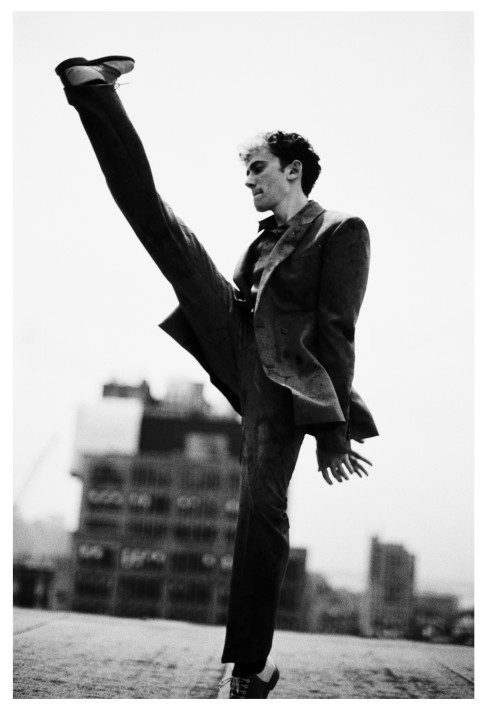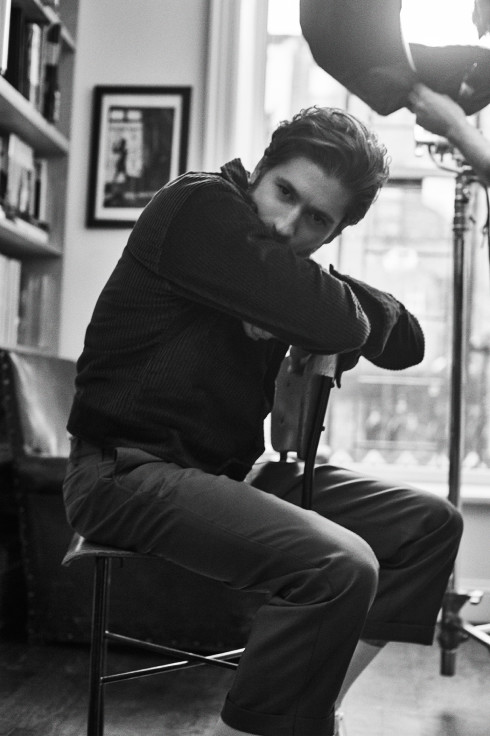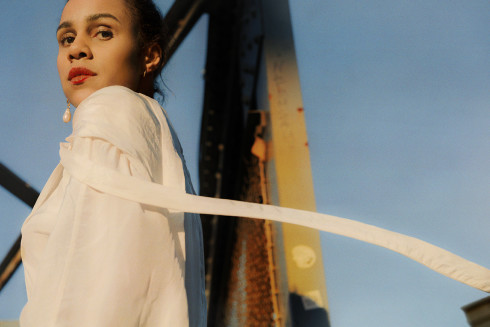- By
- Jonathan Shia
- Photography by
- Sacha Maric
- Styling by
- Aryeh Lappin
Hair by Yohey Nakatsuka at Defacto Inc using Kérastase. Grooming by Yui Ishibashi at Defacto Inc using MAC Cosmetics. Photographer’s assistant: Dylan MacDonald. Stylist’s assistant: Sam Knoll. Shot at Slate Studios, New York.
Isaac Powell Is a Tony for the Twenty-First Century
Even before it opened in February, the experimental Belgian director Ivo van Hove’s radical reimagining of the iconic musical West Side Story was being hailed as an update for the twenty-first century, surfacing its more confrontational aspects behind the cheery façade and catchy songs. Now the show, along with the rest of Broadway, has been shut down for an extended hiatus due to the coronavirus pandemic, but the continuing movement for racial justice sparked by the murder of George Floyd at the hands of the Minneapolis Police Department has only sharpened the production’s relevance. In this modern-day retelling of Romeo and Juliet, racism and nativism course through the storyline, which traces the star-crossed lovers Maria and Tony as they struggle futilely to bridge the divide between two ethnically segregated gangs, the Sharks and the Jets. At a time when issues of race are at the forefront of the national conversation, West Side Story, which first premiered on Broadway in 1957, feels fresher than ever, and van Hove’s vision, complete with live video projections and contemporary hip hop- and Latin-inspired choreography by the celebrated Belgian avant-gardist Anne Teresa De Keersmaeker, draws out the show’s darker themes. “I think that for so long, there were so many things that got swept under the rug that have been happening since 1957,” emphasizes Isaac Powell, who plays Tony with intense passion and open-hearted honesty. “There are so many things that I never even saw in West Side Story because of the way that the story was told and because it was presented as this period piece and it was a musical, ‘light fare.’ I never really took any of it super seriously, but when I revisited the script after I found out I had gotten this part, I found things about police brutality and about xenophobia and all of these things that we’re still dealing with as a country. What’s interesting about doing it as a contemporary piece is I don’t think audiences can keep it at arm’s length anymore. I think when they’re confronted with young kids in contemporary clothes dealing with contemporary things, they’re not able to say, ‘Oh that was America in the 1950s.’ This is what we’re still dealing with today and I think that it just makes it more immediate and makes it more impactful to be presented in this way.”

Van Hove’s version of West Side Story, originally written by the all-star trio of Leonard Bernstein, Stephen Sondheim, and Arthur Laurents, makes an impactful first impression with its casting, featuring a vividly diverse mix of actors and dancers, dozens of whom are making their Broadway debuts. The company reflects the youth of America today, refracting and shattering the central tension between the white Jets and Puerto Rican Sharks into a complicated tangle of sharp facets. Powell has a Black father and a white mother, while Shereen Pimental, who stars opposite him as Maria, has both Puerto Rican and Jamaican heritage. Dharon E. Jones—who replaced the blond-haired, blue-eyed Ben Cook as Tony’s lifelong best friend Riff after an injury—is Black, and Maria’s brother Bernardo is portrayed by the New York City Ballet principal Amar Ramasar, whose father is of Trinidadian and Indian descent and whose mother is Puerto Rican. Casting actors of color as the Jets may seem at first to blunt the show’s critique of race divisions, but as the descendants of Polish, Irish, and Italian immigrants, the original teenage gang members were also historically seen, to a lesser degree, by the established majority as something less than fully American, a reminder that it has been the work of centuries to define this nation. Here, race serves to separate them not only from each other but from a larger society that works to oppress them all.
Powell, who first starred on Broadway in the Tony-winning 2017 revival of Once on This Island just months after graduating from college, admits he didn’t have any interest in West Side Story at first but jumped at the chance to work with the groundbreaking van Hove and de Keersmaeker, both of whom helped shaped the form of late-twentieth-century performance in Europe through their inventive contributions to theater and dance. “I always wanted to do the kind of theater that Ivo does, but I got my start in musical theater here and it’s sort of hard to break that mold of being a musical theater actor,” he says, “so I didn’t know if I’d ever get to work with Ivo,” who is best known internationally for his innovative and provocative productions of Shakespeare, Chekhov, Sophocles, and O’Neill and in New York for directing A View from the Bridge, The Crucible, and Network on Broadway. “When I saw that he was reviving a musical, I freaked out and told my fiancé I would sweep the rehearsal-room floors just to be in the room with them making it,” Powell laughs. “I didn’t care what part I was, I didn’t care what my involvement was. I just wanted to be with them making this thing.”

For those who question the wisdom of allowing two of Europe’s most adventurous artists to unpack one of the most American of musicals, Powell offers a compelling rejoinder. “I think because they are European they have a really interesting perspective about the United States and where we are as a nation,” he argues. “Because they’re somewhat removed from it, there’s less passion for them and more of an objective point-of-view about what our country looks like, what our political landscape is like, and it’s really interesting having somebody having that perspective that’s a little more removed.” The show’s original opening was delayed due to an injury to Powell’s knee—De Keersmaeker’s choreography is particularly athletic, and the torrential downpour van Hove unleashes onstage nightly elevates the risk level—but the continuous revisions leading up to the final product hinted at another criticism the team confronted. As the New York Times reported in January, cast demands led to the hiring of Tony-winner Sergio Trujillo and ballet dancer Patricia Delgado as dance consultants to lend an “authentically” Latinx perspective to De Keersmaeker’s work. The inevitable discussion of who has the right to tell which story continues to loom, as it does over so many works of creative expression. The end result, says Powell, is reflective of the collaborative process that De Keersmaeker oversaw. “I think it made it a lot more honest and a lot more authentic to us because so much of it was coming from us and so many of our ideas are embedded in it,” he explains. “Our choreography is embedded in it. We made this thing—with their guidance and with their direction, but they didn’t come in prescribing anything to us. It was really what we brought to the table that’s presented on that stage and they guided it and shaped it.”
It may come as a surprise to find Powell playing one of musical theater’s most iconic roles barely over two years after moving to New York, but his career has always been marked by a certain precocity. After years of playing sports as a child in Greensboro, North Carolina, he found his way to the stage after being convinced one summer by some girls his sister was babysitting to audition for a local production of The Wizard of Oz, in which he played a Munchkin. “I was like, ‘I would rather do this than play soccer,’ and I just fell absolutely in love with being in a rehearsal room, with putting on costumes, with being on stage with this group of crazy kids whose energy matched mine,” he recalls. He quickly shifted focus to community theater and spent his senior year of high school in a rigorous boarding program at the University of North Carolina School of the Arts before entering the BFA program there, forging the right combination of luck, rigor, and practicality. “It was at UNCSA that I really realized that I could actually make this dream a reality,” he says, “with practice and with diligence and going about it the right way—that there was kind of a formula for it. It wasn’t all just dreams and aspirations. There’s actually things that I could do to further myself in this career and carve a path for myself.”

The summer before his senior year, Powell participated in a theater intensive and met the writer Nikko Benson, who was then working on his biographical electropop musical Nikola Tesla Drops the Beat. When the show made its premiere at the Adirondack Theatre Festival in the summer of 2017, Powell played the title role. “It was a really formative experience,” he recalls. “That was huge for me because I was the only person in that cast who was young and had not yet moved to New York and the whole cast just took me under their wing. They were all people who were in Broadway shows and they really instilled a lot of confidence in me and made me feel like I could actually do this.” During the run, he was asked to audition for the upcoming revival of Once on This Island and, after sending in a tape and making the trip down to the city on his day off for a single meeting, he was offered the lead role of Daniel, the love interest in a romance set in the French Antilles. “I graduated May 6, then I made my Broadway debut on November 9,” he laughs. “I hadn’t even moved to New York yet. I had two weeks to pack up all my stuff and find a place in New York to move before rehearsals started. It was wild.”
Powell disarmingly admits to having felt out of his depth during the show’s run, which culminated in a Tony for Best Revival of a Musical over heavy favorites Carousel and My Fair Lady. “Because I went into it so quickly after school, I feel like I went into that process with the mindset of a student instead of as a professional actor,” he elaborates. “I was just waiting for someone to hold my hand and guide me through it and tell me what choices to make and tell me how to do this thing, but I didn’t have that. That was really shocking to me at first. I felt sort of naked and sort of forgot how to do my job. I forgot how to deconstruct a script, how to approach a character, all of these things. I was waiting for someone to tell me to do that.” He muses that he would like the chance to do it over again, before quickly countering himself, saying that he understands now that he needed that trial by fire to prepare him for Tony.

This summer, Broadway is taking its longest intermission in history. Given the health risks of crowding several hundred mostly-elderly patrons into cramped seats for over two hours, theater was quickly shut down in March after New York City announced its first cases of COVID-19. Shows are currently scheduled to resume on January 3, 2021. During this pause, the crusade for racial equity sweeping across American society has hit Broadway as well. Recently, a coalition of over three hundred Black, Indigenous, and people of color artists released a statement, “We See You, White American Theater,” calling for necessary changes in a hidebound and heavily traditional art form. Come January, Broadway will, as so many institutions are working toward now, have to present a new model for moving forward. This “West Side Story for the 21st-century” might offer one example of a way to remake the old into something a little juster. For Powell, that ability—that need—to adapt is one of theater’s most valuable qualities. “People don’t want to mess with things like this, but I think that’s ridiculous,” he argues. “Theater is not made to be preserved in amber. It’s not made to just be carbon-copied and replicated over and over. There’s a certain market for that, but I think it’s so much more interesting when we can turn these things on their heads and look at them in a new lens and from a new perspective. The movie that was made in the 1960s will always be there and those performances are going to be the exact same any time anybody sees it and that beautiful choreography is preserved forever, so why not use this opportunity to try something a little bit different? That’s what I try to express to people who are like, ‘Why would you mess with it? Don’t reinterpret a classic.’ The classic’s always there. You can rent it on Amazon for $2.99 and watch it there, but there’s no progress in that. If we just continue to retell the stories in the way that they’ve always been told and pretend like we as a society haven’t changed, we’re doing a disservice to the art form and to society.”
West Side Story returns January 3, 2021.

- By
- Jonathan Shia
- Photography by
- Sacha Maric
- Styling by
- Aryeh Lappin
Hair by Yohey Nakatsuka at Defacto Inc using Kérastase. Grooming by Yui Ishibashi at Defacto Inc using MAC Cosmetics. Photographer’s assistant: Dylan MacDonald. Stylist’s assistant: Sam Knoll. Shot at Slate Studios, New York.


















